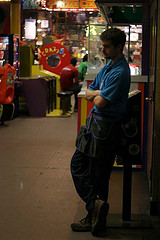 A recent trip to Boston’s Institute of Contemporary Art made me wonder how museums might curate video games and other digital media. The challenge is fitting an interactive and often social medium into the traditionally hands-off and reserved context of most art museums. As might be expected, the ICA resolves this tension by shunting most digital media off into a separate, youth-oriented space. (American museums seem to assume that adults like to stand aloof from art, which baffles me).
A recent trip to Boston’s Institute of Contemporary Art made me wonder how museums might curate video games and other digital media. The challenge is fitting an interactive and often social medium into the traditionally hands-off and reserved context of most art museums. As might be expected, the ICA resolves this tension by shunting most digital media off into a separate, youth-oriented space. (American museums seem to assume that adults like to stand aloof from art, which baffles me).
Hanging underneath the cantilevered body of the museum is the “Mediatheque,” a digital cockpit reminiscent of a WWII bomber ball turret. It currently houses some 16 Macs through which patrons can access digital exhibits and a refreshingly current social-tagging and discussion feature. But as the picture below of a girl multi-tasking on her mobile phone illustrates, culture is racing ahead faster than installations.
In some ways a gallery of video games would face similar challenges as a museum of film – truly appreciating a game may take hours. Aggressively curating the selection to highlight particular aspects of the game – art, sound, and most of all gameplay – can help solve this, but the curator then runs into serious software issues. Taking an “excerpt” out of a game is nothing at all like doing the same for film – how might the exhibit highlight only one of the later levels in Super Mario Bros., for example? Then there are the hardware challenges, especially for more recent games that cannot be played or emulated on the PC.
 Assuming that the technical issues can be resolved, how might a good curator assemble the collection? Some of the easier organizing logics would be historical, perhaps starting as early as the “Cathode Ray Tube Amusement Device.” One important segment might attempt to define “video game,” perhaps highlighting board games, sport, and film for comparison. Another angle might focus on video game assets such as art or audio; yet another would be to highlight major genres.
Assuming that the technical issues can be resolved, how might a good curator assemble the collection? Some of the easier organizing logics would be historical, perhaps starting as early as the “Cathode Ray Tube Amusement Device.” One important segment might attempt to define “video game,” perhaps highlighting board games, sport, and film for comparison. Another angle might focus on video game assets such as art or audio; yet another would be to highlight major genres.
But most important of all, a proper video game exhibit must get to the heart of a game’s interactivity. The full art of video games surfaces when the act of engaging them reveals something about the human condition – whether it’s about yourself or your relationship to the world. Many of these might have to be small indie games, with an emphasis on “small.” Putting Super Mario Bros. next to Braid might demonstrate some of the conventions that the latter challenged, but won’t really help the player experience obsession (one of the major themes of Braid), at least not within an acceptable time frame. So a significant amount of “telling” will, I’m afraid, have to be done.
The picture of the girl on her mobile reminds us that any exhibit would do well to think beyond the four corners of the screen. As with the ICA’s innovative tagging system, it might even be possible to create an interactive exhibit that integrates the rest of the museum. (Museum as ARG, anyone?)
I would love to hear other ideas for how one might go about exhibiting video games qua video games. Thoughts?
(btw, Rochester’s Strong Museum of Play will soon be opening one of the largest video game exhibits in the world. I’m curious how they’re tackling the challenge.)


